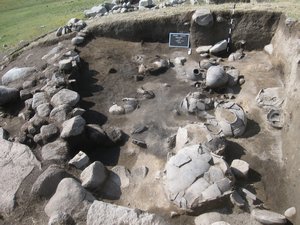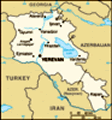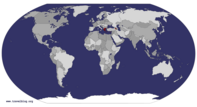Advertisement
Published: July 28th 2010

 The Hoard...
The Hoard...
Eight days of excavation, forty-four pots, 2 bronze arrowheads, 2 obsidian points, and eight days later, it's been quite a ride.Thanks to a thunderstorm, we've returned from the field a bit early today, and, since the power is out in the house, and the local network database that we use to keep track of the excavation won't work without the router, I'm finally finding time to write the entry I promised last week but never got around to doing. The reason for this is simple: the intact jar I discussed in last week's post was only the first of forty four complete (though, in many cases, fragmented) ceramics: everything from small medicine jars, drinking cups and bowls, to large grain or wine storage vessels. Because of this, I've spent most of the last week excavating and removing these ceramics during the day, and entering data about them into the database at night. It really is a fantastic find, though we're not entirely sure what it represents. Nevertheless, for the ArAGATS project (and for South Caucasian Late Bronze Age Archaeology in general) such a wealth of ceramic vessels promises to provide significant new knowledge. For one thing, the fact that these vessels were all found together will help to tighten the dating schemes based on the ceramics because we now know that

 The Close-Up
The Close-Up
This photo gives you a better idea of how the pottery was laid out in the trench. In some cases whole vessels were sitting just beneath, or even, inside broken ones. Even more interesting, large, burned timbers (probably from the roof) were found broken across some of the large pottery.each type of vessel present in the trench was used concurrently (see Blog #5 from last year for a review of basic archaeological principles...). But, ceramics will only ever allow us to date archaeological levels/layers relatively-- that is to say, if we only use ceramic styles for dating we will never be able to say "this event occurred in 1624 BCE," but instead "this event happened before that one, and after that other one." That said, one of the fantastic things about the deposit in my trench is that it is associated with a very substantial destruction layer (to describe this destruction level as "fantastic" is, of course, a matter of perspective-- fantastic for us as archaeologists... but obviously less than fantastic for the ancient people whose homes were destroyed/ransacked), and within this layer (most likely due to a large fire which burned across the whole site) are a number of burnt roofing timbers and wall beams. These may help us to provide a much more precise, calendrical date for the destruction one of two ways: radiocarbon dating, or dendrochronology. Radiocarbon (C14) dating is based on the concept that all living things maintain a particular ratio of the isotopes Carbon-14,

 Ancient Fruit Bowl
Ancient Fruit Bowl
Probably my favorite of the 44 pots, what I affectionately have been calling "my fruit bowl" was found entirely intact, sitting on its own, and has a beautiful "circle and ladder" design around the outside. Not too far from something I might find in Mom's kitchen...Carbon-13 and Carbon -12 in their bodies while alive, however, once dead, the C14-- which is vaguely radioactive-- begins to decay into C13 and C12, and we know at what rate this decay occurs. By measuring the amount of C14 left in an organic material such as bone, seeds, or wood, we can figure out how long it has been dead, and hence, how long ago the tree was cut down to make timber, the animal was slaughtered for food, etc., providing a rough date for the occupation (or in this case, destruction) of the site. Dendrochronology, on the other hand, is based on the fact that most (though not all...) trees create an annual growth ring (remember counting the rings to tell how old a tree was in Elementary School?). The size of these growth rings is affected by the tree's ability to get water, nutrients, sunlight, etc., and trees of the same species, living in the same climatic region and during the same time period will produce similar size rings based on the availability of water, nutrients, sunlight, etc. in that location. By measuring the sizes of the rings across a one-hundred or two-hundred year old tree, a

 Garni
Garni
Wait... what is a Greco-Roman temple doing in Armenia? Good question. Probably wanting to cozy up to the Romans who were fighting the Parthians near by, a local king built this tomb (probably not a temple) in the 2nd century AD.pattern begins to emerge of good growth years (i.e. big rings) and bad growth years (i.e. small rings). After measuring tens or hundreds of tree samples (both alive and dead), a more statistically robust "chronology" can be produced, which can show what years in a forest's life were good for specific species' growth and which were not. Then by overlapping the growth pattern from the early years of one tree's life, with the final years of another (and doing this tens or hundreds of times), a "dendrochronology" can be developed which reaches back thousands of years (a dendrochronology in Ireland, based predominantly on ancient oaks preserved in bogs stretches back to c. 11,000 BCE). Archaeology can benefit from dendrochronology since the tree rings in wood beams can be read, compared with local or regional dendrochronologies, and in many cases, the archaeological samples can be matched to a time period with 99.7% accuracy. The error associated with dendrochronology is much less than that of C14 dating (in an ideal situation, dendrochronology should allow use to pinpoint the cutting down of a tree to the year, and in some cases to a season-- like spring or fall; whereas C14 often comes with

 Chachkar
Chachkar
Reminiscent of carved Celtic crosses, these stone stele were created by monks during the Middle Ages as a way of connecting with God.a + 50 to 100 years), the trouble is, in many cases wooden beams do not preserve to a level that their rings can be measured. In any case, it seems that the destruction level at Gegharot (at least in my trench) has samples which may be promising for dendrochronology-- and since Cornell has a world-renowned dendrochronology lab, of which my advisor is the director, we'll give it a shot.
Removing the ceramics themselves, was a complicated process (not aided by the weather, since it drizzled or rained at some point almost every day last week). On the one hand, we needed to make sure that all the fragments of a specific ceramic made it into the same bag (this will help conservators at the museum reconstruct the ceramics for analysis and display), and on the other, while the intact ceramics were often quicker to remove, we also wanted to save any soil inside the ceramics for analysis (looking for seeds or pollen) to help tell us what each vessel contained (if anything at all) when the destruction occurred. In order to keep track of them all, we photographed, drew and labeled most of the week, and finally, starting on

 The Road More Traveled
The Road More Traveled
After hundreds of years of treading by monks and visitors, these steps show the wear. They lead up to some of the monks cells built right into the gorge walls.Friday morning, began to remove the ceramics, finishing up on Saturday. In addition to the beautiful ceramics, we've also found a bronze arrowhead, an obsidian arrowhead, and a number of grinding stones in the trench. All in all, a really fantastic find-- which kept me very busy for a while. Adam turned to me on Friday morning when we were first lifting the ceramics and said "Enjoy this part... because entering all this into the database is going to be a grind..." He was right.
From a cultural perspective, last weekend (i.e. 7/17-7/18) went spent Saturday night in Yerevan, staying with one of the graduate students who's helping out with the project, and is on a Fulbright Fellowship here until November, then visited the National Museum and two sites on Sunday. It was nice to get back to a big city on Saturday evening-- we went to a Mexican restaurant for dinner (but Armenian Mexican, while not awful, has a long way to go to catch up with US Tex-Mex), and headed to a few bars, rounding off the night in a Jazz Club, where we met Albert Hughes, a US director and film producer (most recently he and

 You Have Chosen Wisely...
You Have Chosen Wisely...
My immediate reaction, when I walked into this room carved out of the rock at Geghard? This would've been a great place to film the final scenes of "Indiana Jones and the Last Crusade"-- there were even Medieval knights buried in the floors... but no ghosts to speak of...his brother directed "The Book of Eli" with Denzel Washington starring). Nice guy-- he is half African-American, half Armenian, and was just visiting Armenia with his girlfriend and friend, in an attempt to get back to his roots-- though after a week, he seemed happy to have some other Americans to shoot the breeze with.
After a french toast breakfast on Sunday (which included french-press coffee-- a rare luxury, as we only have instant at the dig house), we met up with Lori at the National Museum and saw some of the amazing material which has been recovered from Neolithic, Bronze Age and Medieval sites throughout Armenia. The highlight of these were two largely intact wooden carts from the Late Bronze Age (c. 1600-1200 BCE) which were discovered in a large grave in western Armenia. Other objects, like a wooden bow and arrows, and a series of metal weapons were also recovered-- all in all, the find of a lifetime-- but strangely enough (and really par for the course) these incredible discoveries are rarely taught about and discussed outside the Caucasus and the former Soviet Bloc. After the museum, we headed off to Garni, a 2nd century AD temple or tomb (scholars debate over this), which resembles Greco-Roman building styles. Also in the vicinity, are a small Roman bath and the ruins of a 7th century church. Next, it was off to Geghard, a medieval monastery (which is still used by Armenian monks today), sitting at the bottom of a gorge, and set, in some cases, literally into the rock. Parts of the church were carved out from the gorge wall, while others were built around it. Almost all of the monks' cells are carved into the rock as well. Many of the monks, it seems, spent their time carving khshkars (kha-sh-kars) which are akin to Celtic Cross, in that they are carved into stone, and always incorporate a cross at the center, but also have extraordinary levels of intricate detail and design. We ended the night by visiting a Georgian restaurant in Yerevan on the way home (in large part because one of the other graduate students on the project, Dima, is a Georgian). We got back to Aparan late, but full with good food and good experiences, and with tons of pictures.
I hesitate to promise that I'll write another post this week (though I will try!) since every time I do, I end up missing my deadline. In any case, things in T27 have begun to slow down (though still interesting) which has allowed me to learn how to play Backgammon (locally called "Nardi"), and practice nightly (while what I really should be doing is working on a Fulbright Fellowship proposal...). To sum up: all is good in Armenia. I hope this post finds you all well back home-- not too long until I'll see many of you again.
All the best,
Jeff
Advertisement
Tot: 0.07s; Tpl: 0.012s; cc: 7; qc: 51; dbt: 0.0411s; 1; m:domysql w:travelblog (10.17.0.13); sld: 1;
; mem: 1.2mb










Aunr Maggie
non-member comment
Once again, Jeff, I really enjoyed reading this blog. Like the others, it's like a mini history lesson... I'm liking it!!! Keep 'em coming.... or write a book or something, your writing is very easy to read... thanks!!! See you soon.